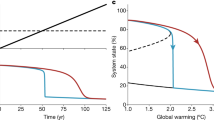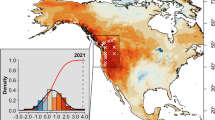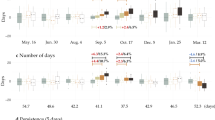Abstract
Targets for stabilizing climate change are often based on considerations of the impacts of different levels of global warming, usually assessing the time of reaching a particular level of warming. However, some aspects of the Earth system, such as global mean temperatures1 and sea level rise due to thermal expansion2 or the melting of large ice sheets3, continue to respond long after the stabilization of radiative forcing. Here we use a coupled climate–vegetation model to show that in turn the terrestrial biosphere shows significant inertia in its response to climate change. We demonstrate that the global terrestrial biosphere can continue to change for decades after climate stabilization. We suggest that ecosystems can be committed to long-term change long before any response is observable: for example, we find that the risk of significant loss of forest cover in Amazonia rises rapidly for a global mean temperature rise above 2 ∘C. We conclude that such committed ecosystem changes must be considered in the definition of dangerous climate change, and subsequent policy development to avoid it.
This is a preview of subscription content, access via your institution
Access options
Subscribe to this journal
Receive 12 print issues and online access
$259.00 per year
only $21.58 per issue
Buy this article
- Purchase on Springer Link
- Instant access to full article PDF
Prices may be subject to local taxes which are calculated during checkout



Similar content being viewed by others
References
Hare, B. & Meinshausen, M. How much warming are we committed to and how much can be avoided? Clim. Change 75, 111–149 (2006).
Wigley, T. M. L. Global mean-temperature and sea level consequences of greenhouse gas concentration stabilisation. Geophys. Res. Lett. 22, 45–48 (1995).
Gregory, J. M. & Huybrechts, P. Ice-sheet contributions to future sea-level change. Phil. Trans. R. Soc. Lond. 364, 1709–1731 (2006).
Cox, P. M. & Jones, C. D. Illuminating the modern dance of climate and CO2 . Science 321, 1642–1644 (2008).
Cox, P. M., Betts, R. A., Jones, C. D., Spall, S. A. & Totterdell, I. J. Acceleration of global warming due to carbon-cycle feedbacks in a coupled climate model. Nature 408, 184–187 (2000).
Friedlingstein, P. et al. Climate-carbon cycle feedback analysis, results from the C4MIP model intercomparison. J. Clim. 19, 3337–3353 (2006).
Jones, C. D., Cox, P. M. & Huntingford, C. in Avoiding Dangerous Climate Change (eds Schellnhuber, H. J., Cramer, W., Nakicenovic, N., Wigley, T. & Yohe, G.) (Cambridge Univ. Press, 2006).
Matthews, H. D. Decrease of emissions required to stabilize atmospheric CO2 due to positive carbon cycle-climate feedbacks. Geophys. Res. Lett. 32, L21707 (2005).
Sitch, S. et al. Evaluation of the terrestrial carbon cycle, future plant geography and climate-carbon cycle feedbacks using 5 Dynamic Global Vegetation Models (DGVMs). Glob. Change Biol. 14, 2015–2039 (2008).
Stern, N. Stern Review on the Economics of Climate Change (Cambridge Univ. Press, 2006).
Wigley, T. M. L. The climate change commitment. Science 307, 1766–1769 (2005).
Ridley, J. K., Huybrechts, P., Gregory, J. M. & Lowe, J. A. Elimination of the Greenland ice sheet in a high CO2 climate. J. Clim. 18, 3409–3427 (2005).
IPCC. Contribution of Working Group II to the Second Assessment of the Intergovernmental Panel on Climate Change (eds Watson, R. T., Zinyowera, M. C. & Moss R. H.) (Cambridge Univ. Press, 1996).
Cox, P. M. et al. Amazonian forest dieback under climate-carbon cycle projections for the 21st century. Theor. Appl. Climatol. 78, 137–156 (2004).
Betts, R. A. et al. The role of ecosystem-atmosphere interactions in simulated Amazonian precipitation decrease and forest dieback under global climate warming. Theor. Appl. Climatol. 78, 157–175 (2004).
Scholze, M., Knorr, W., Arnell, N. W. & Prentice, I. C. A climate-change risk analysis for world ecosystems. Proc. Natl Acad. Sci. USA 103, 13116–13120 (2006).
Salazar, L. F., Nobre, C. A. & Oyama, M. D. Climate change consequences on the biome distribution in tropical South America. Geophys. Res. Lett. 34, L09708 (2007).
Phillips, O. L. et al. Drought sensitivity of the Amazon rainforest. Science 323, 1344–1347 (2009).
Lowe, J. A. et al. How difficult is it to recover from dangerous levels of global warming? Environ. Res. Lett. 4, 014012 (2009).
Kohlmaier, G. H., Hager, C., Nadler, A., Wurth, G. & Ludeke, M. K. B. Global carbon dynamics of higher latitude forests during an anticipated climate change: Ecophysiological versus biome-migration view. Wat. Air Soil Pollut. 82, 455–464 (1995).
Joos, F. et al. Global warming feedbacks on terrestrial carbon uptake under the Intergovernmental Panel on Climate Change (IPCC) emissions scenarios. Glob. Biogeochem. Cycles 15, 891–907 (2001).
Ruckstuhl, K. E., Johnson, E. A. & Miyanishi, K. Introduction. The boreal forest and global change. Phil. Trans. R. Soc. B 363, 2243–2247 (2008).
Macdonald, G. M., Kremenetski, K. V. & Beilman, D. W. Climate change and the northern Russian treeline zone. Phil. Trans. R. Soc. B 363, 2283–2299 (2008).
Betts, R. A. et al. Future runoff changes due to climate and plant responses to increasing carbon dioxide. Nature 448, 1037–1041 (2007).
Harrison, S. P. & Prentice, I. C. Climate and CO2 controls on global vegetation distribution at the Last Glacial Maximum: Analysis based on palaeovegetation data, biome modelling and palaeoclimate simulations. Glob. Change Biol. 9, 983–1004 (2003).
Golding, N. & Betts, R. A. Fire risk in Amazonia due to climate change in the HadCM3 climate model: Potential interactions with deforestation. Glob. Biogeochem. Cycles 22, GB4007 (2008).
European Council. Limiting Global Climate Change to 2 ∘C—The Way Ahead for 2020 and Beyond Communication from the Commission to the Council, the European Parliament, the European Economic and Social Committee and the Committee of the Regions (2007).
Jones, C. D. et al. Strong carbon cycle feedbacks in a climate model with interactive CO2 and sulphate aerosols. Geophys. Res. Lett. 30, 1479 (2003).
Jones, C. D. & Cox, P. M. Constraints on the temperature sensitivity of global soil respiration from the observed interannual variability in atmospheric CO2 . Atmos. Sci. Lett. 2, 166–172 (2001).
Nakićenović, N. et al. Special Report on Emissions Scenarios (Cambridge Univ. Press, 2000).
Acknowledgements
This work was supported by the Joint DECC, Defra and MoD Integrated Climate Programme—DECC/Defra (GA01101), MoD (CBC/2B/0417_Annex C5).
Author information
Authors and Affiliations
Contributions
C.J. experiment design, analysis, C.J. and J.L. analysis and text, S.L. carried out model simulations, R.B. advice on design, analysis and text.
Corresponding author
Supplementary information
Supplementary Information
Supplementary Information (PDF 563 kb)
Rights and permissions
About this article
Cite this article
Jones, C., Lowe, J., Liddicoat, S. et al. Committed terrestrial ecosystem changes due to climate change. Nature Geosci 2, 484–487 (2009). https://doi.org/10.1038/ngeo555
Received:
Accepted:
Published:
Issue Date:
DOI: https://doi.org/10.1038/ngeo555
This article is cited by
-
Critical transitions in the Amazon forest system
Nature (2024)
-
Green internet of things and solar energy
Environmental Science and Pollution Research (2023)
-
Loss of soil organic matter in the mining landscape and its implication to climate change
Arabian Journal of Geosciences (2023)
-
Pronounced loss of Amazon rainforest resilience since the early 2000s
Nature Climate Change (2022)
-
Automatic detection of airborne pollen: an overview
Aerobiologia (2022)



